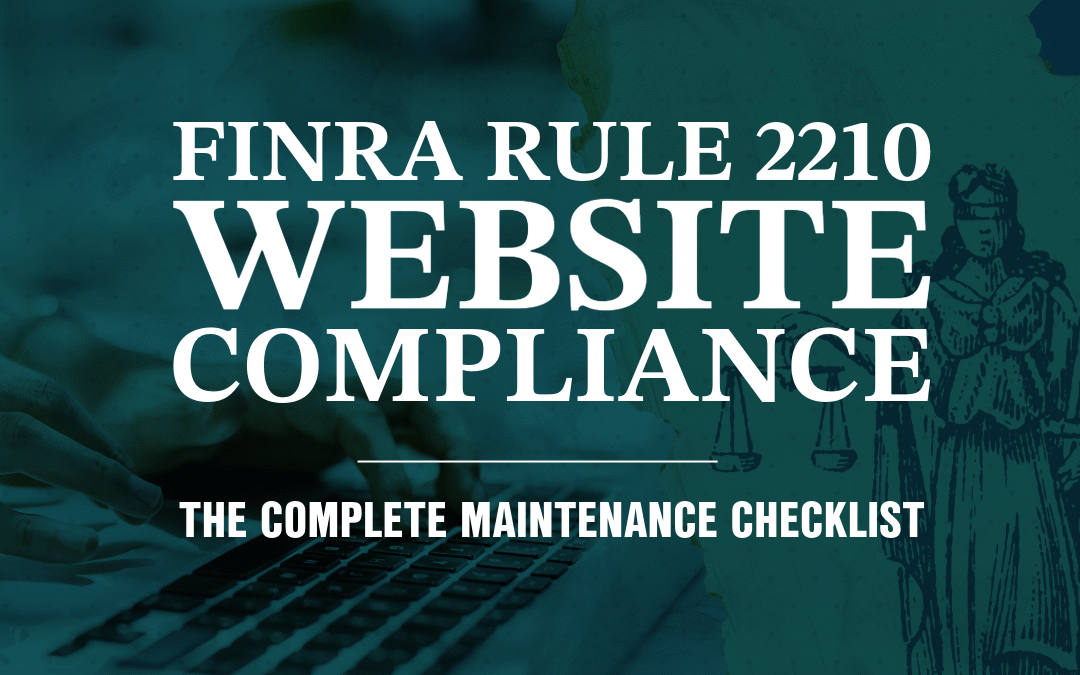“If you think a compliance audit is boring, wait until you get a deficiency letter.”
As usual, my disclaimer: I am not an attorney and I am certainly not your attorney. These are just examples of what you might do, and as always, get your attorney and compliance officer to review this stuff before you implement anything. Also, things change all the time, so things may have changed since this was written.
I. Introduction: FINRA Rule 2210 Essentials
If you’re a financial advisor, RIA, or run an investment firm with even a whiff of client-facing digital presence, FINRA Rule 2210 applies to you. Ignore it, and you’re inviting fines, forced takedowns, or – if you’re lucky – a very expensive rebranding exercise. Rule 2210 governs “communications with the public,” but don’t let the legalese lull you. Your website, landing pages, calculators, even that “About Us” video? All fair game.
Here’s what’s changed: FINRA’s guidance now zeroes in on ongoing website maintenance – not just a one-time compliance check. That means routine audits, disclosures that don’t hide on mobile, and tracking every tweak you make (yes, even that typo fix).
Immediate Stakes: One missed disclaimer or out-of-date risk warning can turn a client dispute into a regulatory nightmare. If you’re not actively maintaining compliance, you’re not compliant.
Read on, and you’ll walk away with a maintenance checklist, the tech stack you actually need, and the vendor questions to ask before you hand over the keys to your site.
II. Understanding FINRA Website Classifications
Where Most Firms Get Sloppy: “Is My Website Retail Communication?”
A few years ago, a client insisted their site was just “online correspondence, so the rules didn’t really apply.” Here’s the rub: FINRA classifies most public-facing websites as “retail communications,” not simple correspondence.
Correspondence vs. Retail Communications
- Correspondence: Targeted to 25 or fewer retail investors within any 30-day period. Think: direct emails, one-on-one messages.
- Retail Communications: Everything else – including your main website, blogs, and most social posts.
Key Takeaway: If your site is accessible to the general public, it’s “retail communication” and subject to the full weight of Rule 2210.
Approval Requirements
- Correspondence: Post-use review, not pre-approval – unless it’s a template reused for multiple clients.
- Retail Communications: Pre-use principal approval required before publishing. This means every landing page, every calculator, every downloadable PDF needs eyes on it from someone with a Series 24 or equivalent.
Maintenance Implications
- Routine Reviews: Any content changes, new features, or added disclosures must go through the same approval pipeline. Yes, even that “minor” FAQ update.
- Version Control: You need to track who approved what, when, and what changed. (No more “we’ll fix it later” Slack messages.)
Electronic Communications Requirements
Recordkeeping Obligations
Remember that blog post you deleted after it tanked on Google? FINRA still wants a record. Rule 2210 cross-references SEC Rule 17a-4:
- You must retain all website versions and correspondence for at least three years.
- That includes comments, calculators, and even third-party widgets.
Supervision Protocols
- Ongoing Monitoring: Designate a principal to supervise not just the initial site, but all modifications.
- Escalation Path: Document what happens if compliance flags an issue – don’t just rely on “Kevin in IT” to remember.
Third-Party Content Responsibility
Embedding market data feeds, social media widgets, or curated news? Congrats—you’re now responsible for compliance of that content, too.
Pro tip: Document due diligence on every third-party data source.
III. Essential FINRA Compliance Elements for Websites
Required Disclosures
Firm Identification and Registration
Your firm’s full legal name, CRD number, and registration status must be prominent, not buried in 6-point font at the footer.
Actionable Fix: Add these to your header/footer, and make sure they display on mobile.
Risk Disclosure Statements
Any discussion of investments, performance, or financial products? You need clear, conspicuous risk warnings. “Past performance is not indicative of future results” isn’t optional—it’s non-negotiable.
Performance Disclaimers
If you’re showing actual performance, cite the relevant period and methodology.
If you’re showing hypothetical or backtested results, add a prominent “this is hypothetical” disclaimer and explain the limitations.
Hypothetical Performance Warnings
Don’t just say, “these are hypothetical.” Spell out that real results may differ, and include any assumptions (fees, reinvestment, market conditions).
Key Takeaway: If a reasonable person could be misled, you’re on thin ice.
Content Standards
Fair and Balanced Presentation
Every claim must be balanced with risks and limitations.
Example: If your homepage says, “Our clients outperform the market,” you’d better have a risk disclaimer and supporting evidence front and center.
Prohibition Against False or Misleading Statements
- Don’t cherry-pick best periods.
- Don’t bury risks.
- Don’t use language like “guaranteed” or “no risk.” (Unless you want to meet your friendly neighborhood investigator.)
Supporting Documentation
You must be able to produce backup for every claim, stat, or chart—on demand.
Keep a documentation folder synced with every content update.
Specific Website Compliance Areas
Social Media Integration Compliance
It’s 2025, so yes, your Twitter/X feed and LinkedIn buttons count.
- Archive all posts that appear on your site.
- Supervise automated feeds for rogue or non-compliant content.
Third-Party Link Management
If you link to outside resources, you’re responsible for the context.
- Add disclaimers: “This link leads to a third-party site not affiliated with [Firm].”
- Regularly check that links don’t redirect to spam or inappropriate content.
Client Testimonial Regulations
Testimonials? Welcome to a regulatory minefield.
- Advisors can use testimonials, but must include clear disclosures about compensation, typical results, and conflicts of interest.
- Never edit testimonials to remove negative feedback.
Performance Advertising Restrictions
- No hypothetical projections unless you meet exhaustive requirements (methodology, risks, assumptions).
- No selective cherry-picking of best-performing products or periods.
IV. Monthly Website Maintenance Compliance Checklist
Content Review Process
- Performance Data Verification and Updates
- Cross-check all performance data with source systems. Remove or update out-of-date stats.
- Disclosure Accuracy Confirmation
- Validate that every disclosure is current, visible, and matches regulatory language.
- Link Functionality and Compliance Review
- Run a link checker. Confirm all links work and lead to intended resources.
- Third-Party Content Approval Status
- Re-verify all widgets, calculators, or embedded feeds for compliance.
Technical Compliance Checks
- Recordkeeping System Functionality
- Test your archival system. Can you retrieve a snapshot of the site from three months ago?
- Backup and Archival Processes
- Confirm regular backups are running and retrievable.
- Security Compliance Verification
- Review SSL, encryption, and access controls. (A data breach will compound your compliance woes.)
- Mobile Responsiveness for Required Disclosures
- Open your site on a phone. Are all disclosures visible and legible?
Pro Tip: Set a recurring calendar reminder for these tasks. Skipping a month is not an option.
Documentation Requirements
- Change Log Maintenance: Log every site update, who made it, what changed, and who approved it.
- Approval Tracking Records: Attach principal approval for every content update.
- Review Completion Documentation: Keep a monthly checklist with sign-off by a principal or compliance officer.
V. Quarterly and Annual Compliance Protocols
Quarterly Reviews
- Comprehensive Content Audit
- Review every page, post, and downloadable asset for compliance.
- Regulatory Update Implementation
- Apply new FINRA or SEC guidance promptly.
- Performance Metric Compliance Verification
- Reassess all displayed performance data and underlying calculations.
- Third-Party Vendor Compliance Assessment
- Confirm your web host, CMS, and third-party tools still meet security and archival requirements.
Annual Compliance Certification
- Full Website Compliance Audit: Bring in a fresh set of eyes (internal or external).
- Policies and Procedures Review: Update your compliance manual to reflect new tech, workflows, or regulations.
- Staff Training Verification: Document annual training for everyone with site access.
- External Compliance Consultation: Schedule a review with an outside compliance consultant—don’t trust your own memory.
VI. Technology Solutions for FINRA Compliance
Automated Monitoring Tools
- Content Change Tracking Systems: Use platforms like Smartsheet or Siteimprove for site change logs and alerts.
- Compliance Alert Mechanisms: Set up automated alerts for unauthorized changes or missing disclosures.
- Archival and Recordkeeping Solutions: Integrate with Pagefreezer or Hanzo for real-time website archiving.
Workflow Management
- Approval Process Automation: Use tools like Jira or Monday.com to require and track principal sign-off.
- Review Scheduling Systems: Automate reminders for monthly and quarterly compliance reviews.
- Documentation Management Platforms: Centralize change logs, approvals, and compliance records in a secure, searchable system.
Sidebar: “But Can’t I Just Use WordPress Plugins?” Short answer: Plugins help, but don’t replace human oversight. If you rely solely on tech and skip the manual reviews, you’re rolling the dice.
VII. Working with Compliance-Focused Website Maintenance Providers
Vendor Selection Criteria for FINRA Compliance
- Regulatory Experience: Ask for specific examples where the vendor has helped firms pass a FINRA audit.
- Archival Capabilities: Can they produce site snapshots on demand?
- Security Standards: Do they meet industry standards for encryption, access controls, and incident response?
Service Level Agreement (SLA) Essentials
- Guaranteed Response Times: For compliance issues, every hour counts.
- Regular Maintenance Schedule: Monthly and quarterly reviews written into the contract.
- Change Approval Workflow: Vendor must document principal sign-off on every modification.
Ongoing Compliance Support Requirements
- Proactive Monitoring: Vendor should monitor for new regulatory guidance and propose updates.
- Audit Support: They should assist with documentation production and regulatory responses.
Emergency Response Protocols
- Incident Management: Immediate notification and escalation process for breaches, non-compliance findings, or regulator inquiries.
- Backup Recovery: Vendor should be able to restore prior site versions within hours.
Downloadable Assets
Rapid-Fire Takeaways
- Your website is “retail communication.” Treat every page, tool, and post as subject to full FINRA Rule 2210 scrutiny.
- Document everything. If you can’t prove approval or produce old site versions, you’re exposed.
- Automate, but verify. Tech tools help, but don’t skip the manual, principal-led reviews.
- Third-party content is your problem. Vet and document every integration.
- Partner with vendors who live and breathe compliance. Not just web designers.
Action Steps
- Download the maintenance checklist and start your first monthly review today.
- Audit your approval process: Can you prove every change was reviewed by a principal?
- Schedule a compliance audit with your website team—now, not “next quarter.”
Ever been burned by a compliance surprise? Have a horror story or a war chest of tips?
Reply, connect with me on LinkedIn, or grab the templates above. I’m always up for a good audit story—or helping you avoid becoming one.

Authored by: Jason Long
Jason is a serial problem solver and entrepreneur with 20+ years of experience in business building.
Jason’s ventures range from agriculture to healthcare with a focus on web-based technology. He has extensive experience in software development and has operated as a developer, UX designer, graphic designer, project manager, director, executive coach, and CEO.
Linkedin
Personal Website
Sources:
